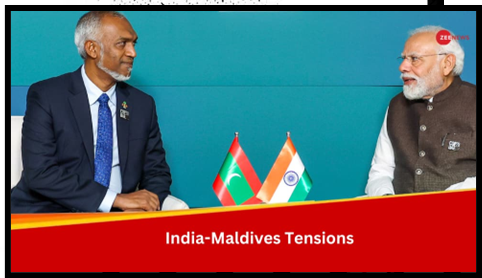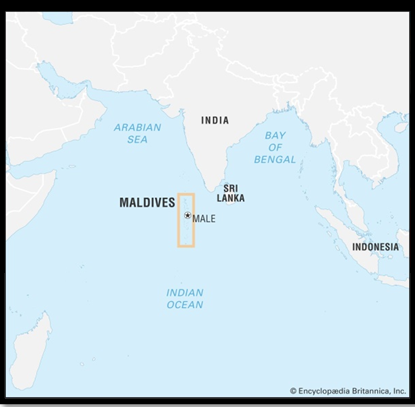A CHANGE FOR THE WORSE
Relevance:
GS 2
- India and its neighbourhood- relations.
Why in News:
Prime Minister Modi’s social media posts advocating tourism in Lakshadweep sparked a heated exchange involving Maldivian politicians, government officials, and Indian social media users.
Source- ZeeNews
In the world of diplomacy and international relations, the power and reach of social media have become increasingly significant. A prime example of this occurred when India’s Prime Minister, Narendra Modi, took to social media to promote tourism in Lakshadweep, setting off a contentious exchange between Maldivian politicians, government officials, and Indian social media users. This incident serves as a compelling illustration of how digital platforms can shape and influence diplomatic interactions in today’s interconnected world.
- Context: The recent downturn in relations between India and the Maldives post the meeting between Prime Minister Narendra Modi and Maldivian President Mohamed Muizzu.
- Incident Trigger: Controversial tweets from Maldivian Ministers criticizing Mr. Modi and his policies, leading to a diplomatic rift.
- Immediate Reactions: Deletion of tweets, suspension of Ministers, and diplomatic summoning of Ambassadors.
- Public Response: Calls for an economic boycott of the Maldives by Indian citizens on social media.
Underlying Issues and Broader Implications
- Political Shifts: President Muizzu’s rise to power with the PPM’s “India Out” campaign and its impact on bilateral relations.
- Diplomatic Choices: Muizzu’s decision to visit Turkey and China, deviating from the traditional prioritization of India by Maldivian Presidents.
- Military Tensions: Ongoing concerns regarding the presence of Indian military personnel in the Maldives.
The Need for Diplomatic Reassessment and Cooperation
- Maldives’ Dependence: The strategic importance of India for the Maldives in terms of geography, economy, and security.
- India’s Strategic Approach: The necessity for India to reconsider its strategy towards smaller neighboring countries.
- Past Benefits of Stronger Ties: Highlighting the positive outcomes of the previous Solih government’s close relationship with India.
- Regional Stability: The importance of maintaining stable bilateral relations amidst political changes in the region.
The China Angle:
- Strategic Concerns: Analysis of Maldives’ increasing engagement with China and its implications for India’s regional influence.
- Geopolitical Dynamics: Understanding how Maldives’ closer ties with China alter the balance of power in the Indian Ocean.
- Economic Factors: The role of Chinese investments in the Maldives and its potential influence on Maldivian foreign policy decisions.
The Way Forward: Strategies for Rebuilding India-Maldives Relations
- Diplomatic Engagement: Proposals for high-level talks and diplomatic initiatives to mend and strengthen ties.
- Economic Collaboration: Exploring avenues for increased trade and investment to bolster economic interdependence.
- Regional Stability: Emphasizing the importance of cooperative security arrangements to maintain peace in the Indian Ocean region.
- Cultural and People-to-People Ties: Enhancing mutual understanding and cultural exchanges to foster goodwill between the two nations.
In conclusion, the recent strain in India-Maldives relations calls for a strategic reassessment and renewed diplomatic efforts. Bridging differences through dialogue, leveraging economic interdependence, and fostering cultural exchanges are vital steps towards rebuilding a robust bilateral relationship. It is imperative for both nations to navigate these challenges cooperatively, ensuring regional stability and mutual growth.
Geography of Maldives: A Strategic Hub in the Indian Ocean
· Unique Location: Maldives is strategically positioned in the Indian Ocean, serving as a significant point of entry for maritime traffic. · Critical Sea Lanes: It lies at the crossroads of two crucial sea lanes of communication (SLOCs) in the southern and northern parts, facilitating maritime trade between the Gulf of Aden and Gulf of Hormuz in West Asia and the Strait of Malacca in Southeast Asia. · Natural Features: The Maldives’ physical geography is characterized by extensive coral reefs and atolls, contributing to its distinct natural beauty. · Exclusive Economic Zones (EEZs): A substantial portion of the Maldives falls within Exclusive Economic Zones (EEZs), granting the country economic rights over these vast marine territories. · Climate Vulnerability: The low-lying nature of the Maldivian islands makes them highly susceptible to the impacts of rising sea levels, emphasizing the region’s vulnerability to climate change. · Geopolitical Significance: The Eight Degree Channel separates the Maldives from Indian Minicoy, part of the Lakshadweep Islands, underscoring the strategic importance of the Maldives in the geopolitical landscape of the Indian Ocean. |
| India-Maldives Relations
Political Ties: · India’s early recognition of Maldives’ independence in 1965. · Strong ethnic, linguistic, cultural, religious, and commercial ties. · Both nations are founding members of SAARC, South Asian Economic Union, and South Asia Free Trade Agreement. · Mutual support in international forums such as the UN, Commonwealth, NAM, and SAARC. · Memorandums of Understanding (MoUs) covering areas like hydrography, health, customs, and civil service training. Strategic Importance: · Maldives’ location near key shipping lanes vital for energy supplies to China, Japan, and India. · Integral role in India’s ‘SAGAR’ vision and ‘Neighbourhood First Policy’ in the Indian Ocean Region (IOR). Defence Collaboration: · Agreement on sharing ‘White Shipping Information’ between Indian Navy and Maldives National Defence Force. · Joint military exercise ‘Ekuverin’ conducted by India and Maldives. Trade and Economic Ties: · Bilateral trade agreement since 1981 facilitating the export of essential commodities. · India’s supply of food items, construction materials, and favorable trade balance. Development Assistance: · India’s support in diverse areas, including healthcare, education, infrastructure, and technology adoption. · Projects like Indira Gandhi Memorial Hospital, Maldives Institute of Technical Education, airport redevelopment, and more contribute to Maldives’ development. |
| Various Indian Operations in Maldives
Operation Cactus 1988: · In Operation Cactus, the Indian Armed Forces played a pivotal role in assisting the Maldivian government in quelling a coup attempt. Operation Neer 2014: · Operation Neer saw India providing crucial support to Maldives during a drinking water crisis by supplying much-needed drinking water. Operation Sanjeevani: · As part of Operation Sanjeevani, India extended a helping hand by delivering 6.2 tonnes of essential medicines to Maldives, aiding in the country’s battle against the COVID-19 pandemic. |
Source
The Hindu
Mains Question
Q “Discuss the recent strains in India-Maldives relations, analyzing the underlying causes and their implications for regional stability. Assess the importance of diplomatic efforts in preserving and strengthening bilateral ties.”

 Source- ZeeNews
Source- ZeeNews Source: Britanica
Source: Britanica

